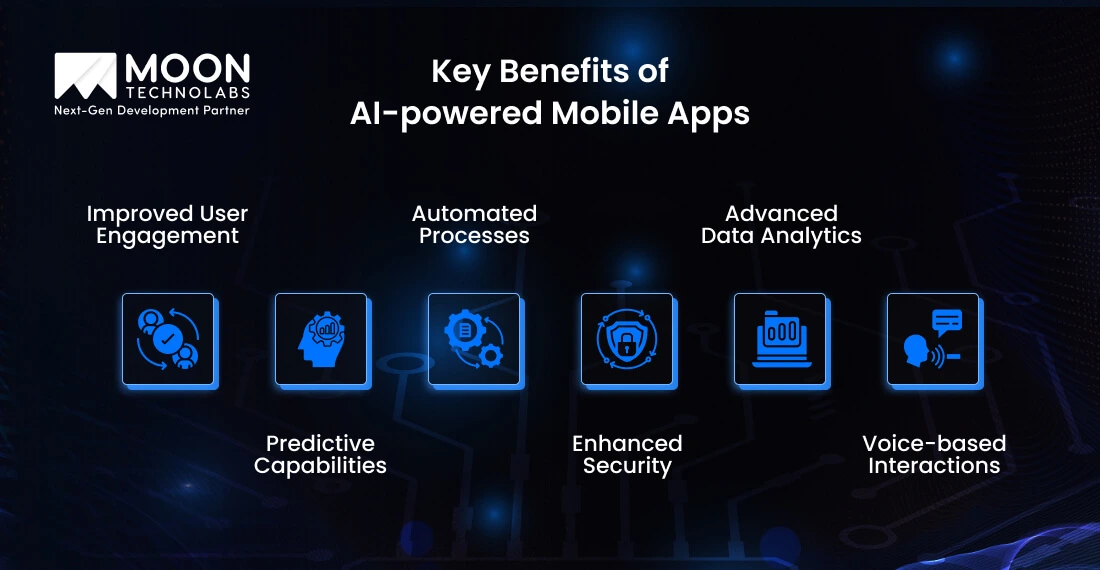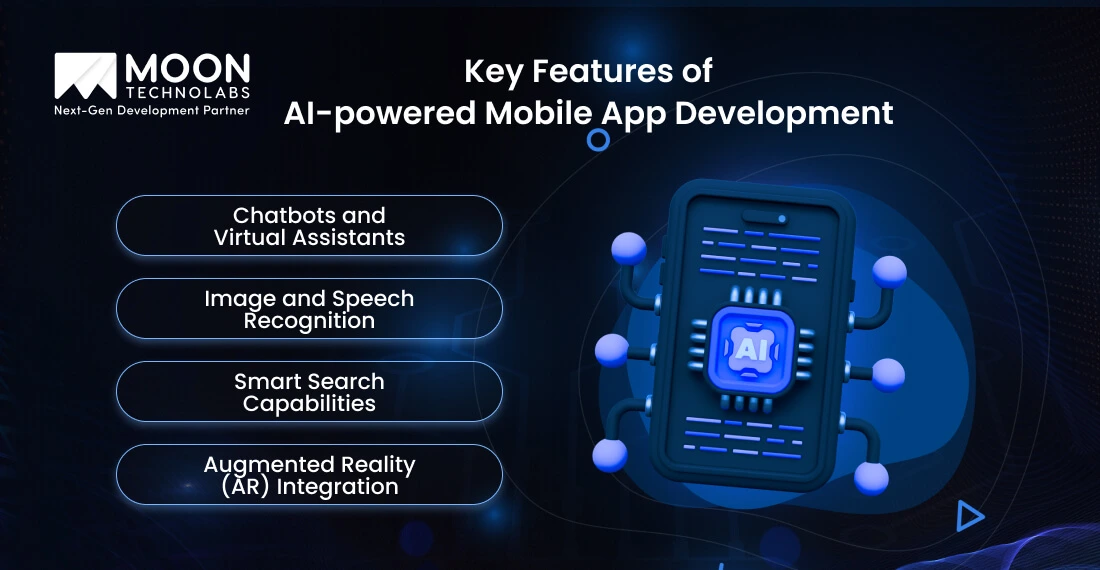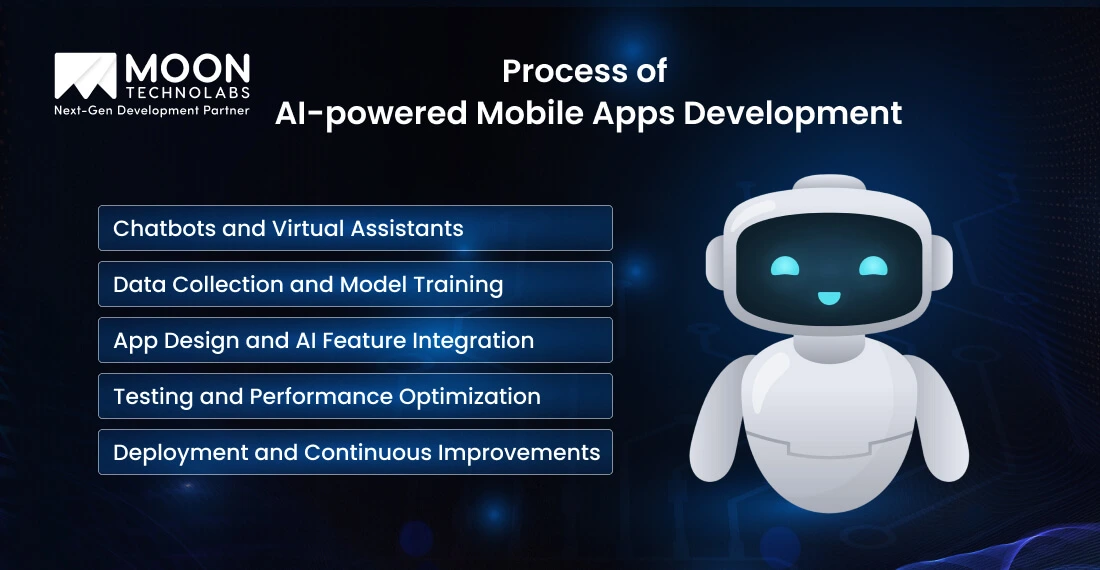Table of Content
Blog Summary:
AI-powered Mobile App Development is transforming how businesses create intelligent, adaptive, and user-centric applications. Unlike traditional apps, AI-driven solutions learn, predict, and personalize experiences in real time. Businesses need these apps to automate tasks, enhance engagement, and stay ahead of competitors. This blog explores why AI-powered apps are the future, how they solve key business challenges, and the latest advancements shaping mobile app development.
Table of Content
If you observe the evolution of Artificial Intelligence (AI), you’ll see how past knowledge, such as models and algorithms, influences future innovations.
Before Deep Learning (DL) became mainstream, AI models were trained for one task and were repurposed for another related task. However, in 2016, Google introduced the Transformer architecture.
It changed how AI processes information about entire sequences at once, leading to AI-Powered Mobile App Development by understanding language and improving the text. With Transformer architecture, the world was then introduced to the field of Natural Language Processing (NLP).
NLP paved the way for more recent models like bidirectional encoder representations from transformers (BERT), generative pre-trained transformers (GPT), and more powerful ones like Gemini, ChatGPT, Bard, and Claude.
Today, these models, combined with their dependencies like Word2vec, RNN, and Ngram, have been the reason behind developing powerful AI apps like FenadoAI and a blueprint for developing retail shopping assistants by NVIDIA AI Enterprise and Omniverse.
This blog will explore more of how crucial AI integration is for modern apps, shedding light on features, tech stacks, and processes.
AI-powered mobile app development goes well beyond automation. Since modern apps focus on user experience, AI delivers it in ways that were previously unthinkable.
Building an app with AI integration at each stage of the cycle optimizes and improves the software. The ability to see feature updates and improvements while continuously developing a product makes it relevant and competitive in the market.
Ultimately, this leads to better predictions about product performance and user satisfaction.
Predict What Users Want
By analyzing massive datasets, AI can help businesses predict what users want. AI does this by understanding their behavior, patterns, and feedback by retrieving text. Then, it uses the insights to generate human-like responses to help them understand what works best for them.
Identify Hidden Patterns with Deep Research
With this new data-driven approach, they can create new products by identifying patterns that sometimes slip from human scrutiny. By adding generative AI, these products can be tested based on different iterations and prototypes during the early design stages.
Make the Final Product More Adaptable
Before launching a product, all these collectively help fine-tune the features through simulations and real-life scenarios that increase its adaptability and productivity. Hence, businesses can offer distinctively innovative products by integrating AI in mobile apps, making it crucial for any application development cycle.
The traditional rule-based approach for developing mobile applications relies on fixed logic, where developers write fixed code to define app behavior. However, AI-powered mobile app development integrates learning capabilities, automation, and intelligent decision-making.
Let’s understand what makes this difference powerful with some examples of apps:
With traditional development, an on-demand healthcare app will face issues like long wait times, generic responses, and no personalized recommendations. However, integrating AI can power this app with NLP and ML, where AI matches them with available doctors and provides instant medical assistance with chatbots.
In traditional banking app development, user interaction is limited to manually finding services like bill payments and receiving generic offers. However, integrating AI in mobile apps, such app interactions will analyze user behavior and offer personalized financial product recommendations, such as home loans or personal loans.
In an episode of The Vergecast podcast focused on the once mega-popular productivity app Evernote, the co-host explains how AI powered its development process. This highly useful storage app became stagnant for 10 years because it relied on manual search functions, making it difficult to retrieve information quickly.
However, when it embedded an AI-driven search, automated note suggestions, and smart categorization, it became highly efficient and cost-effective for both old and new users.
T-Mobile’s customer support system is a great example of how the adaptive behavior of AI-powered application development changes customer interactions compared to traditional approaches.
Collaborating with Qualcomm and Brain.ai, it introduced an AI chatbot that simplifies user interactions by understanding user commands and patterns across various daily task apps.
E-commerce apps are the most common example of personalized product recommendations. Traditional app development works on showing generic category-based recommendations and manual searches.
AI in mobile apps uses recommendation engines to suggest relevant products based on user browsing history, behavior, and purchases.
Reduce wait times and speed up responses by understanding user preferences and behavior with AI automation.

AI powers mobile apps by offering a user engagement that gets smarter the more users interact with them. In addition to automating workflow processes, AI, with its prediction powers, analyzes data, interacts through voice, and even upgrades the security of mobile apps.
Let’s understand how:
AI-powered mobile application development offers an interactive user experience by engaging users based on their usage history, search intent, and buying patterns. It helps determine what users want by understanding what they are looking for using complex algorithms.
With AI working behind the scenes, your business can solve a major challenge of customer drop-offs when they browse and vanish by predicting what users want before they even realize it.
For businesses that deal with endless orders, AI in mobile apps can power their operations of tracking requests and managing inventory by auto-updating, predicting shortages, and optimizing delivery routes. DHL and FedEx are two big names using AI for such operations.
AI-powered app development prioritizes the user’s identity and grants permission access with authentication features. These apps use different types of biometric measures, such as face, voice, fingerprint, senses, and gestures, and they have innovative functions.
Apps powered by AI can analyze massive datasets in real time and provide actionable insights instantly by tracking customers’ behavior and even building better pricing strategies. For example, Target and Walmart already leverage AI to analyze data.
Businesses can improve customer experience by understanding natural language by integrating a smart voice assistant in apps. Users can search and get recommendations just by speaking, and it instantly shows options.

A McKinsey study shows that in the next three years, 92% of businesses plan to increase their AI investments in mobile apps with personalized interfaces. All instances of users finding what they want even before they realize it are powered by AI interactions that deliver tailored experiences.
Here are the key features that make them possible:
Voice and conversational assistants make mobile apps smarter by making them more accessible, natural, and human. By understanding the user behavior, language complexities, intent, and context, AI chatbot development provides more relevant and timely responses.
Image recognition makes it easy for apps to analyze and interpret visual data, from scanning documents to detecting objects in photos using tools such as Google Lens. Similarly, speech recognition allows users to interact hands-free by converting spoken language into text for better accessibility.
With smart search, AI-powered apps utilize NLP, voice, and image recognition to ease the process of finding information in an app and increase efficiency. They are capable of understanding their intent, correcting queries, and providing personalized real-time suggestions rather than just matching words.
AR integration in apps blends the digital world with the real world by overlaying digital information on it to visualize and interact with the content directly with the physical world. Enabling users to interact with the apps on virtually any device makes apps more interactive, engaging, and immersive.
AI-powered mobile app development isn’t a one-size-fits-all approach. Whether it’s predictive medical diagnostics in the healthcare industry or hyper-personalized product recommendations in retail and e-commerce, AI smoothly adapts to industry-specific challenges. Let’s understand how it varies:
AI in mobile apps allows users to analyze their symptoms, automate scheduling by sending reminders, and predict needs based on past interactions.
Key Industry Player: Ada Health uses ML, NLP, and knowledge graphs to process symptoms and refine treatment predictions.
In the e-commerce and retail sector, businesses can develop an app that analyzes and anticipates preferences and past choices to suggest the right products at the right time.
Key Industry Player: Xperra uses AI and human intelligence (AHI) to optimize marketing strategies.
AI in mobile apps is overhauling the fintech industry by monitoring transactions to identify suspicious activities. It instantly detects fraud attempts, prevents security risks, and flags unusual patterns.
Key Industry Player: Zest AI uses AI to automate credit risk assessments and underwriting processes.
AI in mobile apps can handle queries for customer bookings, guest experiences, reservations, and checking availability, eliminating wait times.
Key Industry Player: Expedia implements AI to build chatbots to offer personalized recommendations for travel bookings.
AI apps for e-learning help analyze learning pace, identify weak areas, and deliver personalized lesson plans. They also have chatbots for instant explanations and real-time interactive quizzes to keep students motivated.
Key Industry Player: Coursera utilizes AI for personalized course recommendations and automated grading.
The tech stack for integrating AI in a mobile app must be selected considering the specific tasks and use cases. Whether you’re selecting an AI library or a suitable database for storing user data and training data, it’s essential to consider the most efficient inference techniques.
Here is a quick list of the most powerful technologies to use for AI mobile apps:
ML frameworks are tools for building and using ML models relying on mathematical and statistical algorithms. They are specifically designed to solve business problems like regression and clustering.
It’s a basic yet advanced tool, capable of returning a prediction for a given set of data, setting up multiple data pipelines, training multiple machines, and customizing layers.
PyTorch is extremely customizable, is built on the traditional object-oriented programming approach, and has faster training times.
It’s a great tool for running ML model sketches to determine their interpretability. It also provides model analysis tools, like a confusion matrix, to assess a model’s performance.
Back-end frameworks provide the foundation for handling AI model processing and managing databases. They ensure seamless communication between the app and AI algorithms with APIs and real-time data processing.
An AI-friendly language known for its backend logic, data processing, and extensive libraries, such as TensorFlow and PyTorch, Python eases the process of integrating ML models into mobile apps.
Node.js is a lightweight language ideal for chatbots, recommendation engines, and interactive AI features. Its event-driven backend runtime enables real-time data processing and seamless API integration.
Frontend frameworks help create interactive, user-friendly interfaces, ensuring smooth user interactions, fast rendering, and a responsive user experience across devices.
React Native is a JavaScript framework for building cross-platform mobile apps with a single codebase. It supports mobile app development with AI through libraries and APIs on iOS and Android.
Flutter is a Google UI toolkit that enables fast, cross-platform mobile app development with a single codebase. It is known for its high-performance rendering and AI integration capabilities.
Cloud services provide scalable storage, computing power, and AI tools, enabling real-time data processing and model training for enhanced app performance.
AWS streamlines architectures and production processes using foundation and augmentation technologies.
GCP offers a full suite of cloud computing services, making it easier to integrate advanced ML algorithms and providing useful tools for data storage and user authentication.
Azure provides a comprehensive collection of AI services that enable the incorporation of intelligent features like image recognition, speech recognition, and NLP.
Scale your business by improving the app’s usability and personalizing every user interaction with AI apps.

Integrating AI with mobile apps requires a shift in operations management since regular apps are not intelligent enough. Hence, it becomes essential to look at the process from a different perspective since mobile app development requires dealing with a lot of data.
Let’s understand its key steps:
The first step is to define which process or feature will benefit the most from implementing AI. Your objective should be how this AI implementation can improve the time it takes to complete the process. Then, based on the analysis, data from the field will be collected.
Now you know what type of data you want to collect based on the parts where you want to implement AI. It’s important to define your sources of data collection at the beginning of the data fetching process. Then, you refine and clean it to ensure that the AI module is fed accurate and non-duplicate data.
The data fed into the module will define how the app will interact with other features and users. The third step is to understand if you need more APIs and how many would be useful. You would also need more data modeling to make your app fully fledged intelligent.
Testing the performance of the AI model starts by understanding how this implementation will benefit your business and users. Make sure the model is properly optimized for performance in a way that only upgrades the user experience and draws more attention from people.
The last step is to deploy the app, but even after deployment, models need continuous learning and optimization to improve accuracy and roll out updates. This requires using user feedback, real-time data, and performance analytics so that AI models are trained on the latest data by fine-tuning the algorithms.
AI is on its way to open up new gateways to developing even more intelligent, adaptive, and autonomous applications that will reshape the landscape. Self-learning, hyper-personalized, and predictive applications that anticipate user needs before they arise will take over.
Here are some key trends:
With Generative AI in mobile app development, the future is set to enable apps that can dynamically generate UI elements and responses. ML models will analyze real-time user behavior, emotions, and preferences to auto-customize layouts and themes.
Replacing traditional navigation will enable apps to process real-time information with on-device AI models like Apple’s CoreML or Google’s TensorFlow Lite. These models will also be able to analyze and recognize tone, sentiment, and emotional state in voice/text inputs and respond accordingly.
Context-aware AI will help apps detect emotions through voice and facial recognition and adjust features based on the user’s mood and location. Apps will understand context, user intent, and environment to automate tasks and provide smarter assistance in real time.
AI-enabled mobile app development may cost as low as USD 5,000 for a low-end, simplest, and most basic app. These are average apps, and the costs will range from USD 5,000 to a maximum of USD 30,000.
The starting cost for developing a medium-basic AI app that goes beyond basic automation is USD 35,000. These apps don’t require integrating complex learning algorithms and models but use pre-trained models that are fine-tuned according to the app’s integration demands. Hence, they can range up to USD 70,000.
Similarly, the highly complex AI-powered mobile app may have a higher starting range of around USD 80,000, which can go up to USD 1,40,000, and some will cost even more.
The exact costs will depend on the tech stack, strategies, algorithms and models, and data handling techniques. You should also consider the type of industry, as the cost will vary accordingly.
For example, a healthcare app would cost approx. USD 40,000, or a banking industry app would cost around USD 75,000.
Here is a tentative breakdown of how these factors would impact the cost:
| Factors/Features | Average cost additions |
|---|---|
| Complexity of AI model | Basic chatbot: USD 15,000 to USD 30,000 Complex (DL + NLP): USD 70,000 to USD 1,00,000 |
| App animations | On-screen visualization, user visualization, etc. USD 3,000 to USD 20,000 |
| Platforms | Native: USD 30,000 to USD 80,000 Hybrid: USD 20,000 to USD 1,00,000Cross-platform: USD 35,000 to USD 1,20,000 |
| Categories | E-commerce: USD 40,000 to USD 1,80,000 Learning: USD 30,000 to USD 1,20,000 Gaming: USD 70,000 to USD 2,50,000 Social Media: USD 50,000 to USD 2,00,000 |
| Data volume and quality | USD 15,000 to USD 75,000 |
| Third-party Integrations | Payment gateways and APIs – USD 5,000 to USD 25,000 |
| Maintenance | 15% to 30% of total development costs |
Has your business ever struggled to find what your users need in a mobile app, clicking through endless menus or waiting for support? Traditional mobile apps follow static, rule-based systems that lack adaptability, leading to frustrating user experiences.
Whether it is an e-commerce app that can’t suggest relevant products or a banking app that forces customers through tedious steps for every transaction, AI-powered mobile app development can change the game.
With predictive analytics, intelligent automation, and real-time personalization, businesses can enhance customer satisfaction and efficiency. At Moon Technolabs, we help businesses integrate AI-driven solutions, transforming apps into smart, user-friendly experiences.
Get in touch with our AI app development experts.
Don’t let your business still rely on traditional mobile apps that offer outdated app experiences when it can thrive with AI-powered app development. Apps that fail to personalize, adapt, and automate lead to higher drop-off rates and unsatisfied users.
Switch your game with AI-driven mobile apps that don’t just automate processes but also offer a seamless experience that keeps users engaged. They learn from user behavior, predict user needs, and deliver real-time interactions.
From AI chatbots reducing support costs to intelligent search optimizing user journeys, businesses gain a significant edge. If you’re ready to move beyond traditional app development, it’s time to explore how AI can elevate your mobile presence.
01
02
03
04
Submitting the form below will ensure a prompt response from us.